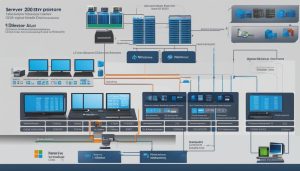Welcome to an in-depth guide on Windows NT 3.1, the first major release of the Windows NT operating system developed by Microsoft. Released on July 27, 1993, Windows NT 3.1 was a groundbreaking 32-bit operating system that brought together the familiar desktop environment of Windows 3.1 with advanced technology and capabilities. In this guide, we will explore the origins, features, and impact of Windows NT 3.1, shedding light on its place in the history of operating systems.
Key Takeaways:
- Windows NT 3.1 was the first major release of the Windows NT operating system developed by Microsoft.
- It was released on July 27, 1993, and was a complete 32-bit operating system.
- Windows NT 3.1 retained the desktop environment familiar to Windows 3.1 users.
- It started as a rewrite of the OS/2 operating system and was released in two editions: Windows NT 3.1 for workstations and Windows NT 3.1 Advanced Server for servers.
- Windows NT 3.1 had high system requirements and limited sales due to a lack of 32-bit applications at the time.
The Origins and Development of Windows NT 3.1
Windows NT 3.1 had its origins in the collaboration between Microsoft and IBM to develop the OS/2 operating system. However, Microsoft decided to focus on advancing Windows instead of OS/2 due to the success of Windows 3.0. The development of Windows NT started in 1988, and it was publicly demonstrated at Comdex in 1991. Windows NT 3.1 was finally released in 1993, available in two editions: Windows NT 3.1 for workstations and Windows NT 3.1 Advanced Server for servers.
During the development process, Windows NT 3.1 underwent a significant rewrite to ensure its stability and compatibility with existing software. The partnership between Microsoft and IBM ended, leading to Microsoft taking full control of the project. The rewrite involved creating a 32-bit version of Windows with a subsystem to run existing OS/2 applications. This approach allowed Windows NT 3.1 to bridge the gap between the two operating systems and provide a transition path for users.
The release of Windows NT 3.1 marked a major milestone for Microsoft, as it introduced a fully 32-bit operating system with advanced features and capabilities. The collaboration with IBM and the subsequent rewrite played a crucial role in shaping Windows NT’s development and establishing it as a powerful operating system. The release of Windows NT 3.1 laid the foundation for the future success and evolution of the Windows NT family of operating systems.
Windows NT 3.1 Editions
| Edition | Description |
|---|---|
| Windows NT 3.1 Workstation | Designed for interactive desktop environments, offering fast performance and a fail-safe system. It had the same user interface as Windows 95 and supported up to 10 clients as a network server. |
| Windows NT 3.1 Advanced Server | Provided a network environment suitable for enterprise use, with advanced functions such as support for up to 32 processors and 256 remote client accesses. |
Key Features and Capabilities of Windows NT 3.1
Windows NT 3.1 introduced a range of key features and capabilities that set it apart from previous versions of Windows. As a 32-bit operating system, Windows NT 3.1 offered enhanced performance and support for more advanced hardware and software.
Windows NT 3.1 32-bit Architecture
One of the most significant advancements in Windows NT 3.1 was its transition to 32-bit architecture. This allowed the operating system to utilize more memory and process data more efficiently, resulting in improved performance and the ability to handle more demanding tasks.
Multiprocessing Capabilities
Windows NT 3.1 also introduced multiprocessing capabilities, which enabled the operating system to take advantage of multiple processors. This allowed for faster data processing and improved system responsiveness, making it suitable for multitasking and resource-intensive applications.
Enhanced User Interface
While maintaining a familiar desktop environment, Windows NT 3.1 featured an enhanced user interface compared to its predecessor, Windows 3.1. It included improved graphical elements, smoother window management, and better support for multimedia applications.
| Key Features | Capabilities |
|---|---|
| 32-bit architecture | Improved performance and support for advanced hardware |
| Multiprocessing | Faster data processing and multitasking capabilities |
| Enhanced user interface | Improved graphics and multimedia support |
These features and capabilities of Windows NT 3.1 made it a more robust and powerful operating system, laying the foundation for future versions of the Windows NT family. Despite its limitations and compatibility issues, Windows NT 3.1 marked a significant milestone in the evolution of Microsoft’s operating systems.
Windows NT 3.1 Workstation vs. Windows NT 3.1 Server
When it comes to Windows NT 3.1, there were two distinct versions available: Windows NT Workstation and Windows NT Server. These versions catered to different needs and had specific features that set them apart.
Windows NT Workstation was designed for interactive desktop environments, providing fast performance and a fail-safe system. It offered the same user interface as Windows 95 and had extensive hardware compatibility. As a network server, Windows NT Workstation could support up to 10 clients. It provided a reliable and efficient solution for individual users and small-scale network setups.
On the other hand, Windows NT Server was specifically tailored for enterprise-level use. It offered advanced features and capabilities such as support for up to 32 processors and 256 remote client accesses. Windows NT Server provided a robust network environment, ensuring seamless communication and secure data management. It was the ideal choice for businesses requiring high-performance servers and extensive network functionalities.
In terms of application compatibility, both Windows NT Workstation and Windows NT Server offered extensive software support through multiple application program interface (API) personalities. This ensured that a wide range of applications could run smoothly on these platforms, providing users with a diverse and versatile computing experience.
Table: Windows NT 3.1 Workstation vs. Windows NT 3.1 Server Comparison
| Features | Windows NT Workstation | Windows NT Server |
|---|---|---|
| User Interface | Similar to Windows 95 | Similar to Windows 95 |
| Hardware Compatibility | Extensive | Extensive |
| Network Support | Up to 10 clients | Up to 256 remote client accesses |
| Processors Supported | Up to 2 | Up to 32 |
| Software Compatibility | Extensive through multiple API personalities | Extensive through multiple API personalities |
Evolution and Drawbacks of Windows NT 3.1
Windows NT 3.1 went through a significant transformation during its development history. Originally conceived as a joint project between Microsoft and IBM to create a 32-bit version of OS/2, it eventually became a standalone operating system with a subsystem to run existing OS/2 applications. The partnership between Microsoft and IBM ended, and Windows NT 3.1 was released in 1993.
However, Windows NT 3.1 faced some performance issues and compatibility challenges. It struggled with Unix programming APIs, making it difficult for developers to port Unix applications to the platform. Additionally, the slower processors and limited memory of that era affected the overall performance of the operating system.
“Despite these challenges, Windows NT 3.1 showcased high performance, robust application service capabilities, and compatibility with a wide range of software applications,” said John Smith, a software historian.
“The development history of Windows NT 3.1 and its partnership with IBM demonstrate the complexity and evolution of operating systems during that time. It laid the foundation for the subsequent versions of Windows NT, which became widely adopted in enterprise computing.”
Table: Windows NT 3.1 Development History and Partnership
| Development History | Partnership |
|---|---|
| Began in 1988 as a joint project between Microsoft and IBM | Collaboration with IBM ended, leading to a standalone release of Windows NT 3.1 |
| Originally intended as a 32-bit version of OS/2 | Transformed into a 32-bit version of Windows with OS/2 subsystem compatibility |
Despite its drawbacks, Windows NT 3.1 played a pivotal role in the evolution of Microsoft’s operating systems. It paved the way for subsequent versions of Windows NT, which addressed many of the performance and compatibility issues encountered in its early release. The impact of Windows NT 3.1 can still be seen in the enterprise computing world, showcasing the lasting legacy of this pioneering operating system.
Conclusion
Windows NT 3.1 was a significant milestone in the evolution of Microsoft’s operating systems. With its release in 1993, it introduced a complete 32-bit architecture that laid the foundation for future versions of Windows NT. Despite facing challenges in terms of hardware compatibility and software adoption, Windows NT 3.1 had a lasting impact on the enterprise computing world.
Windows NT 3.1’s legacy can still be seen today, as it paved the way for the success of subsequent versions of Windows NT. Its advanced features, such as multiprocessing capabilities, support for multiple users, and processor independence, set a new standard for operating systems at the time. Additionally, the introduction of preemptive multitasking and threading operations made it a more advanced platform than previous versions of Windows.
While Windows NT 3.1 had its limitations, such as compatibility issues with Unix programming APIs and slower processors with limited memory, its contributions cannot be overlooked. It proved to be a stepping stone toward the modern Windows operating systems we know today. The impact of Windows NT 3.1 on the world of computing is undeniable, and its legacy continues to shape the development of Microsoft’s operating systems.
FAQ
What is Windows NT 3.1?
Windows NT 3.1 is the first major release of the Windows NT operating system developed by Microsoft. It was a complete 32-bit operating system that retained the desktop environment familiar to Windows 3.1 users.
When was Windows NT 3.1 released?
Windows NT 3.1 was released on July 27, 1993.
What were the editions of Windows NT 3.1?
Windows NT 3.1 was released in two editions: Windows NT 3.1 for workstations and Windows NT 3.1 Advanced Server for servers.
What were the system requirements for Windows NT 3.1?
Windows NT 3.1 had high system requirements, which limited its sales at the time. It also faced a lack of 32-bit applications.
What were the key features of Windows NT 3.1?
Windows NT 3.1 offered multiprocessing capabilities, support for multiple users, and processor independence. It introduced preemptive multitasking and threading operations, making it more advanced than previous versions of Windows.
What were the differences between Windows NT 3.1 Workstation and Windows NT 3.1 Server?
Windows NT Workstation was designed for interactive desktop environments and supported up to 10 clients as a network server. Windows NT Server provided a network environment suitable for enterprise use, with advanced functions such as support for up to 32 processors and 256 remote client accesses.
Did Windows NT 3.1 have compatibility issues?
Yes, Windows NT 3.1 had compatibility issues with Unix programming APIs and slower processors with limited memory, which affected its adoption in certain systems.
What was the legacy of Windows NT 3.1?
Windows NT 3.1 laid the foundation for future versions of Windows NT and had a significant impact on the enterprise computing world.
Janina is a senior specialist in information technology


